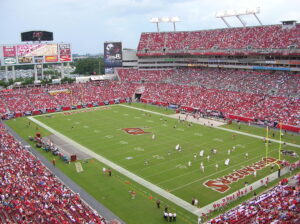Welcome to Four Down Territory! This is a space where I’ll write about four things in professional sports every Saturday. Whether it’s the four greatest moments or the four worst blunders or anything in between, the only rule is that I’ll discuss four things. In my fifth installment, I’ll be outlining the worst pro teams ever to take the diamond, ice, gridiron, and hardwood. These are truly the worst of the worst, so bad that they deserve recognition. Hope you enjoy!
New York Mets (1962)
This one’s for my good buddy Eli, a Mets fan forever beleaguered to mediocrity. You’ll notice several expansion teams on this list, and it makes sense that they would do poorly. After all, there’s no culture when you’re starting out a sports team for the very first time. There’s little expectation for success, and teams have to scrape from the bottom of the barrel for whatever “talent” the rest of the league doesn’t want. Nevertheless, the very fact that the Mets existed felt like a win, because the National League was finally returning to New York after both the Dodgers and the New York Baseball Giants jumped ship across the country. They weren’t about to feel many more wins after that. New York went 40-120, easily the worst record in the league, finishing 60½ games behind the National League leading San Francisco Giants. Perhaps an even worse metric for the Mets is that they finished 24 games behind their expansion brethren, the Houston Colt .45s (still an awesome name). Their players were positively awful. Of those who appeared in at least 80 games for the team, only three position players had an OPS+ better than the league average. The player who contributed their most WAR, Roger Craig, went 10-24 with a 4.51 ERA, 4.55 FIP, and 10.1 hits per 9 innings. Though pitching strategy was far different back then, the win-loss record is quite grisly for a team’s ace. But what we’ll remember most about the Mets of ‘62 is how the fanbase embraced them. Through all the ineptitude and misery, the fans stayed with it, and they came in 6th in the NL for attendance. Seven years after their horrendous inaugural season, the Miracle Mets of ‘69 rewarded their fans with a World Series championship. The first season was but a small price to pay.
Washington Capitals (1974-75)
If you’re a hockey fan, you know the Vegas Golden Knights made the Stanley Cup Finals in their first season of existence. Though they lost to my beloved Capitals, the Knights were in such a position due to more favorable rules surrounding the NHL Expansion Draft. This version of the Capitals is likely why they got such favorable rules. Washington’s Capitals were ineptitude in a tangible form. In 80 tries, they were victorious a measly 8 times. In 40 tries away from the nation’s capital, they won just once. The season was so awful that Hall of Fame GM Milt Schmidt had to step in as coach and even he couldn’t save the Capitals from the embarrassment that was themselves. On average, they allowed 5.54 goals per game, while scoring just 2.26. They had three goaltenders with grisly records: Ron Low was 8-36, John Adams was 0-7, and Michel Belhumeur was 0-24. Interestingly enough, seven of their eight wins were by two goals or more, but it couldn’t make up for how terrible they truly were. Nothing could. After their totally atrocious season and Kansas City’s similarly poor inaugural season, most NHL executives felt that expansion was a grave mistake. The Capitals suffered the same kind of losing, bitterness, and total suckitude for an entire decade. Threats of relocation surfaced around the team in 1982, when a young general manager named David Poile stepped in to save the Caps. He fleeced Rod Langway away from the Canadiens and drafted Scott Stevens, acquiring two Hall of Fame defensemen in one fell swoop. And just like that, the Capitals became relevant, creating a winning culture by amassing thirteen consecutive playoff appearances. Though this generation of Capitals couldn’t capture the Cup, they kept hockey in D.C. and clawed their way back from the worst season in hockey history. Thanks, David.
Tampa Bay Buccaneers (1976)
We make a lot of jokes about how terrible the Browns are, or how the Lions went 0-16. A lot of teams have gone winless in NFL history, but those were mostly teams that played very few games or didn’t have enough players due to World War II (remember Card-Pitt? Me neither). But this was the first team the late night hosts could rip to shreds. To start their season, they played the Houston Oilers in the Astrodome. They went the wrong way down a tunnel, got lost, and eventually had to be guided on the field to start the game. If ever there were foreshadowing for how a season would go, this had to be it. They lost by 20, and things got a lot worse for them. The statistics were putrid: 8.9 points scored per game and 29.4 allowed. The team’s quarterback was 1966 Heisman Trophy winner Steve Spurrier, largely considered one of the biggest busts in NFL history. He barely completed 50% of his passes, throwing for 7 touchdowns and 12 interceptions. It’s mind-boggling to me how successful Spurrier was on the collegiate level, both as a player and a coach, and just how god-awful he was at the pro level. Their head coach, John McKay, was a legend at USC, winning four national championships. To cope with all the losing, McKay was arguably the funniest coach in the history of professional football. Here are a couple selections of my favorite quotes:
“Well, we didn’t block, but we made up for it by not tackling.”
“Can’t stop a pass or a run. Otherwise, we’re in great shape.”
“We’ve determined that we can’t win at home and we can’t win on the road. What we need is a neutral site.”
McKay promised that the team would beat Pittsburgh’s timetable for winning a championship, seeing as it took 41 years for them to capture their first. Technically, he was correct. After the Buccaneers won the Super Bowl in 2003, it had been 27 years since the worst team ever took the field. Eventually, they got their happy ending too.
Charlotte Bobcats (2011-12)
Most of these teams are terrible expansion teams, formed at a time where expansion drafts gave the team no chance to be successful. This is distinctly different, which makes it all the more laughable. This team was owned by the greatest player of all time, and it had been around for several years already, appearing in the playoffs just two short seasons prior to 2011. To be fair, the NBA was in a lockout year, and fan interest would dip no matter what happened. But come on guys, seriously. Be competitive. These Bobcats were an awful mishmash of bad veterans, young guys who you knew could not possibly be franchise players, and Boris Diaw and Kemba Walker hopelessly hanging on to life in the NBA. Diaw was mercifully traded to San Antonio midway through the season, but Kemba had to slog through a year of a waking nightmare. The team won 7 games and lost 59. Anytime Gerald Henderson is your leading scorer and Bismack Biyombo is your leading rebounder, you’re destined for the worst possible fate. In an abridged 66-game season, they still managed to have impressive losing streaks of 16 and 23 in a time where tanking was not a prevalent strategy. The team finished 43 games behind the Eastern Conference leader, and 13 games behind the second-worst team in the East. Their reward was the second overall pick in a draft with Anthony Davis. Unless you’re actually playing basketball, don’t be like Mike, kids. Poor Kemba. The mediocrity he deals with now is somehow better than this “team”, and Charlotte shouldn’t waste his talent anymore. He needs to go to a real NBA team fast.





